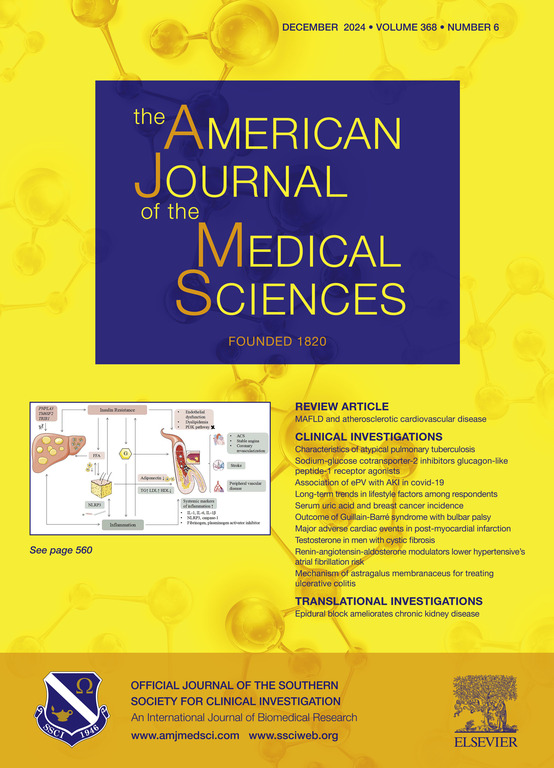Use of mycophenolate mofetil for the treatment of fibrotic hypersensitivity pneumonitis
IF 2.3
4区 医学
Q2 MEDICINE, GENERAL & INTERNAL
引用次数: 0
Abstract
Introduction
The optimal treatment of fibrosing hypersensitivity pneumonitis (fHP) is not well understood. The aim of the study was to obtain information about the usefulness of mycophenolate mofetil (MMF) in its treatment.
Material and methods
Quasi-experimental analysis of patients diagnosed with fHP and treated with MMF for one year, in a single centre. From the start of treatment, data collection was prospective.
Results
73 were included and 58 completed the study. FVC% and DLCO% decreased until starting MMF (year -1 to year 0). After completion of treatment (year 1), FVC% stabilised (p=0.336) and DLCO% improved significantly (p=0.004) compared to year 0. Dyspnoea, number of patients without corticosteroids and mean corticosteroid dose also improved significantly (p<0.001 in all cases). Being male and having a history of tuberculosis were predictors of poor drug response [AUC = 0.89 (95% CI: 0.80-0.98)]. 45 adverse effects were observed in 34 patients (46.6%). In 4 cases (5.5%), the adverse effect was severe and required discontinuation of treatment.
Conclusions
In patients with fHP, MMF improves lung function and dyspnoea and reduces both the number of patients requiring oral corticosteroids and their mean dose in those who completed 1 year of treatment. The model constructed predicts which patients will respond poorly to treatment, with good discriminative ability and only a small percentage of patients will not tolerate treatment. Further prospective, randomised clinical trials are needed to define the role of this treatment in fHP.
使用霉酚酸酯(Mycophenolate mofetil)治疗纤维化超敏性肺炎。
导言:纤维化超敏性肺炎(fHP)的最佳治疗方法尚不十分明确。该研究旨在了解霉酚酸酯(MMF)在治疗中的作用:在一个中心对确诊为 fHP 并接受 MMF 治疗一年的患者进行准实验分析。从治疗开始,数据收集具有前瞻性:结果:共纳入 73 名患者,其中 58 人完成了研究。在开始接受 MMF 治疗前(第 1 年至第 0 年),FVC% 和 DLCO% 均有所下降。完成治疗后(第 1 年),与第 0 年相比,FVC% 趋于稳定(p=0.336),DLCO% 显著改善(p=0.004)。呼吸困难、未使用皮质类固醇的患者人数和平均皮质类固醇剂量也有明显改善(p结论:对于 fHP 患者,MMF 可改善肺功能和呼吸困难,并减少需要口服皮质类固醇的患者人数以及完成 1 年治疗的患者的平均剂量。所构建的模型可以预测哪些患者对治疗反应不佳,具有良好的鉴别能力,只有一小部分患者不能耐受治疗。需要进一步开展前瞻性随机临床试验,以确定这种疗法在 fHP 中的作用。
本文章由计算机程序翻译,如有差异,请以英文原文为准。
求助全文
约1分钟内获得全文
求助全文
来源期刊
CiteScore
4.40
自引率
0.00%
发文量
303
审稿时长
1.5 months
期刊介绍:
The American Journal of The Medical Sciences (AJMS), founded in 1820, is the 2nd oldest medical journal in the United States. The AJMS is the official journal of the Southern Society for Clinical Investigation (SSCI). The SSCI is dedicated to the advancement of medical research and the exchange of knowledge, information and ideas. Its members are committed to mentoring future generations of medical investigators and promoting careers in academic medicine. The AJMS publishes, on a monthly basis, peer-reviewed articles in the field of internal medicine and its subspecialties, which include:
Original clinical and basic science investigations
Review articles
Online Images in the Medical Sciences
Special Features Include:
Patient-Centered Focused Reviews
History of Medicine
The Science of Medical Education.

 求助内容:
求助内容: 应助结果提醒方式:
应助结果提醒方式:


